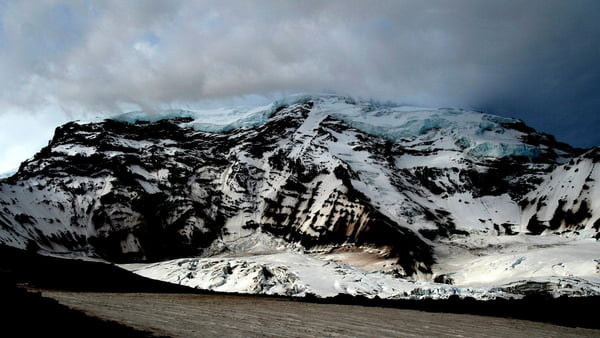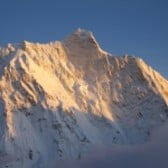
Daily Mountain
48 years, Australia
The Climbers Who Survived a Week Stuck on Mount Rainier
After a climbing partner became ill, high winds stranded Yev Krasnitskiy and his team on the upper reaches of Mount Rainier for five days with no way to go but up.
Mount Rainier’s Liberty Ridge begins at roughly 8,000 feet on the peak’s north face and runs all the way to the 14,411-foot summit. Considered a classic climb, Liberty Ridge is the most technically difficult and dangerous route to the top of Rainier. Only 53 percent of the climbers who attempt the ridge complete it, Yev Krasnitskiy, a 39-year-old systems engineer from Portland, Oregon, has summited Rainier half a dozen times, including one ascent via Liberty Ridge. On June 1 of this year, he began a second attempt of the ridge with three other climbers. What was planned as a long one-day climb became a five-day life-or-death ordeal. Here’s Krasnitskiy’s story, as told to Outside. Two old friends from the East Coast told me they wanted to come out and climb Mount Rainier. I knew them from a mountaineering group I was involved in, and both had plenty of experience. They were bringing a third person I didn’t know very well. He didn’t have high-altitude experience, though he’d done a lot of rock and ice climbing. Our original plan was to spend the first night at 8,200 feet, then another night midway up Liberty Ridge at the Thumb Rock camp, at 10,760 feet. That’s a good acclimation point. But after rockfall killed a climber there the week before our trip, we decided to go for the summit in a single day, starting from the low camp around 10 p.m. on Saturday. Our decision to not spend a second night at high camp turned out to be a costly one. Around 8 a.m. on Sunday, we made it to a saddle around 10,800 feet. Our climber with less experience at altitude was doing well, so we decided to keep going. It gets harder to turn back after that point; the route becomes more dangerous because of loose rock and snow slides. At around 12,000 feet, though, he started feeling the altitude. He wanted to stop and rest, so we took some longer breaks, but it was getting late in morning. The snow was starting to melt, and rocks were beginning to fall. We needed to keep moving, so we put him in the lead so he could move at a pace he was comfortable with. Finally, we got to Black Pyramid, a 1,000-foot rock feature on the right side of Liberty Ridge where steep rock and ice pitches begin. Our sick friend started up the ice on his own without talking to us first and without protection. That was unusual, because he’s a good ice climber. It took him a long time, but he finally set up a belay station after we yelled at him. That’s when we realized he wasn’t responding well. By noon, we were past Black Pyramid. The wind was starting to pick up. Our friend wasn’t doing well, so we decided to try a section of snow to the left of the ice steps that took us off the main route. Around 7 p.m., our friend asked if we could stop and set up the tent. That wasn’t easy in the 40 mph wind. The sun was setting by the time we finally had the tent up. Because we had planned on a short trip, we didn’t have much stuff with us—a few freeze-dried meals, some energy bars, and enough gas to melt a liter of water and make tea for a couple days. I also had a shovel and GPS in my pack. We had our cellphones and a walkie-talkie with us too. We were in a bad place—on an outcropping about the size of a table under an ice cliff. The wind got stronger during the night, ripping the tent and snapping the poles. We tried to secure it by placing our packs and rocks around the edges. Finally, we just stuck our feet between the rocks and held the tent with our bodies. At some point, my pack, containing half the food, fell down the slope. By the time the sun came up on Monday, it was obvious that our friend had hypothermia along with altitude sickness. We didn’t want to take him higher, but taking him down meant we’d have to help him over unstable rock and ice. That’s when we decided to call for help. My phone had a signal, so I dialed 911. But in the rush to give our basic info, I forgot to ask how to communicate with the rangers on our walkie-talkie. We were lucky to have made contact at all. After that, we couldn’t get a signal on any of our phones. Ten minutes later, a ranger helicopter appeared, but it couldn’t land because of the wind. We tried to get to a flat spot so the rangers could drop the litter for our friend, but the helicopter couldn’t get close enough. We set up what was left of the tent as best we could and stayed where we were, hoping the wind would stop long enough for the rangers to reach us. Despite two attempts, one from a larger Chinook, the helicopter still couldn’t get close enough. It was clear that we wouldn’t be able to get our friend airlifted from that spot. During the night, some ice fell on us and completely destroyed what was left of the tent. We dug ourselves out and decided to go up higher. With the rocks, it was just too treacherous to move down. We gathered everything and started climbing again, moving across the ridge to the ice steps we were originally supposed to be on. It didn’t take long until the wind froze us in place, so we sat there and covered up with our sleeping bags. That was the scariest moment. I remember my three partners wanted to sleep—a sure way to freeze to death—so I encouraged them to do everything they could to stay awake and generate heat. It got a lot quieter, except for occasional complaints about being cold and weak. I tried to stay upbeat, telling the rest of the team that this would pass, that we’d eventually get a break in the weather. But nobody was really responding. A few hours later, we finally got a break from the wind. We moved up a few hundred feet and found an ice cave with enough space for the four of us to lie down. Our supplies were down to a few bars, one liter of water, one liter of tea, and a small amount of gas. On Thursday morning, I wanted to leave the ice cave and go up because I thought there was a chance we’d meet other climbers who could pass on a message to the rangers about where we were. Our sick friend was feeling a little better and thought he could keep going, so we got our things together and started moving. As we got onto the final slope to the summit, the weather cleared. Suddenly, a helicopter appeared out of nowhere and landed right next to us. A ranger jumped out and yelled, “Are you the Liberty Ridge group?” They flew us down and transported us by ambulance to Harborview Medical Center in Seattle. Nobody was hurt too badly, even our friend who got sick. My feet looked pretty bad, with blood-filled blisters, but I didn’t end up losing any toes, just some toenails and skin. We were lucky. It could have been much worse. by Jason Daley This article first appeared on http://www.outsideonline.com. The original can be read here. Photo: Daniel Holz/Tandem
Photo: Daniel Holz/Tandem





